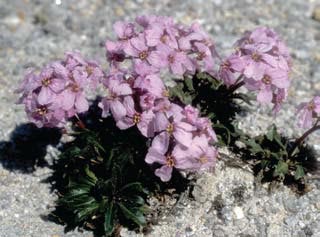
C. Parker
Abstract
Botanical surveys in northwestern Alaska, including the National Park Service’s Inventory and Monitoring (I&M) Arctic Network and Shared Beringian Heritage Program inventories, have made several contributions to our knowl-edge of the regional flora. Three species new to science have been described: Parrya nauruaq, Primula anvilensis, and Douglasia beringensis. The occurrence of six species, previously known only from the Russian Far East and westward, have been documented: Potentilla fragiformis, Ranunculus monophyllus, Saussurea triangulata, Hiero-chloe annulata, Calamagrostis tenuis, and Kobresia filifolia ssp. subfilifolia. Major westward and northward range extensions within Alaska have been documented for several rare species that link northwestern Alaska with the circumpolar high arctic (Draba pauciflora), the Canadian arctic (Festuca edlundiae and X_Dupoa labradorica), and with endemic-rich interior East Beringia (Oxytropis tananensis, Lupinus kuschei, Symphyotrichum yukonense, Carex deflexa, Eriophorum viridicarinatum, and Schizachne purpurascens). Future botanical inventories on both sides of the Bering Strait will certainly yield additional new records and increase our knowledge of this shared Beringian floristic heritage.
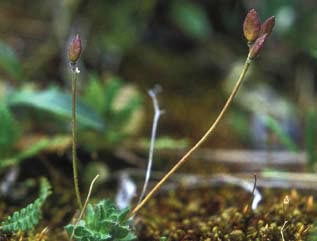
C. Parker
New to Science
Primula anvilensis S. Kelso (Primulaceae) was first described from Anvil Mountain, near Nome (Kelso 1987). Recent collections, including I&M Arctic Network inventories, have documented the species from several additional Seward Peninsula sites, the Nulato Hills, the Baird Mountains, and from Cape Krusenstern National Monument (NM) and Noatak National Preserve (NP) (Parker 1999, 2006a, 2006b).
Douglasia beringensis S. Kelso, Jurtzev, and D. F. Murray (Primulaceae) was first collected during an inventory of Bering Land Bridge NP sponsored by the Shared Beringian Heritage Program and undertaken by a team of Russian and Alaskan botanists in 1992-1993 (Kelso et al. 1994). Additional populations have since been found in the Moon Mountains, northwest of Nome, and in the Nulato Hills, Lime Hills, and Kokrines Hills (Parker 1999, 2000, 2006a, 2006b). The species is ranked imperiled both globally and in Alaska (G2S2).
Parrya nauruaq Al-Shehbaz et al. (Brassicaceae) was first found along the Solomon River on the Seward Peninsula in 1982, but incorrectly identified. It was not recognized as being a new species until after a large popu-lation was found in 2003 in the Moon Mountains, northwest of Nome. (Al-Shehbaz et al. 2007, Parker 2006b). The known distribution of this new species remains restricted to these two localities. Parrya nauruaq is ranked imperiled both globally and in Alaska (G2S2).
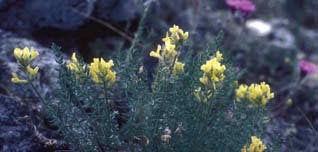
C. Parker
New to North America
Potentilla fragiformis Willd. (Rosaceae) was collected at Sheshalik in Cape Krusenstern NM during the 2001 I&M Arctic Network inventory. This was thought to be the first record in Alaska for this attractive cinquefoil, previously known only from the Russian Far East. However, a careful review of specimens from several herbaria disclosed that it had been collected previously in Alaska, but had been misidentified (Parker 2006a). P. fragiformis is now documented from Kivalina, St. Paul Island, St. Lawrence Island, and the lower Baldwin Peninsula, south of Kotzebue. The species is currently ranked imperiled to critically imperiled in Alaska, although it is widespread globally (G4S1S2).
Ranunculus monophyllus Ovczinn. (Ranunculaceae), a bright yellow buttercup, was collected in 1998 during a BLM survey in the Nulato Hills (Parker 1999). The species is widespread in Russia, Europe, and Greenland. Following the collection in Alaska, a review of herbarium specimens of the similar-looking R. pedatifidus revealed that R. monophyllus had been collected previously at Bluff, on Norton Sound, and at Serpentine Hot Springs in Bering Land Bridge NP, but had been misidentified (Parker 1999). During the 2003 I&M Arctic Network inventory, R. monophyllus was collected in the Hugo Creek headwaters of Noatak NP. The species is currently ranked secure globally and imper-iled in Alaska (G5S2).
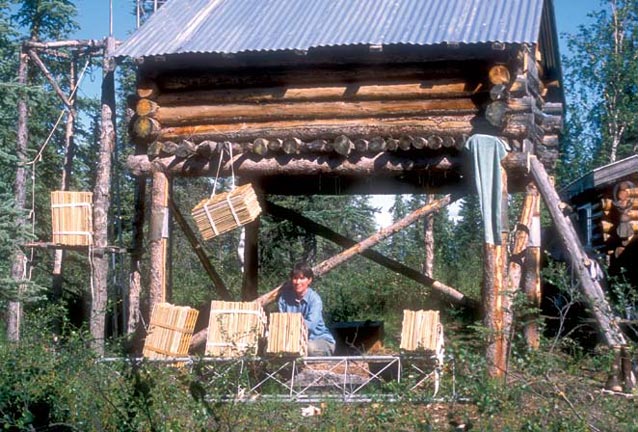
C. Parker
Saussurea triangulata Trautv. & C.A. Mey. (Asteraceae) was first collected in the Waring Mountains in Kobuk Valley NP, and was quickly recognized as being unlike any Saussurea species known from North America (Parker 2001). Taxonomists specializing in the genus from both Russia and U.S. have reviewed this collection and agree the species is new to North America, and possibly new to science. It is provisionally being called S. triangulata, a species known from the Russian Far East and Korea (Keil 2006). During the 2002 I&M Arctic Network inventory, the first known population was revisited, and a second very small population was found approximately 2 miles (3 km) to the northeast. Regardless of its ultimate taxonomic resolution, the species is ranked critically imperiled in Alaska (G?S1).
Hierochloe annulata V.V. Petrovsky (Poaceae); Calamagrostis tenuis V.N. Vassil. (Poaceae); Kobresia filifolia (Turcz.) C.B. Clarke ssp. subfilifolia T.V. Egorova, B. Jurtz. and V.V. Petrovsky (Cyperaceae). These three graminoid species were collected in the central and northern Seward Peninsula during an inventory of Bering Land Bridge NP sponsored by the Shared Beringian Heritage Program in 1992 and 1993 and undertaken by a joint team of Alaskan and Russian botanists. Each of these species has a broad northern Russia distribution; however, these are the first records for each from North America. Rankings for rarity in Alaska have not been established.
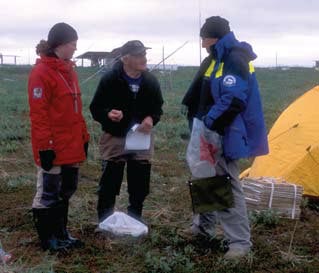
C. Parker
Draba pauciflora R. Br. (Brassicaceae) was collected from two localities on the north slope of the Endicott Mountains during the 2002 I&M Arctic Network inven-tory in Gates of the Arctic National Park and Preserve (NPP) (Parker 2006a). These were the first records from Alaska for this high arctic circumpolar species. A review of similar looking Draba herbarium specimens disclosed that it had been previously collected near Barrow, Alaska, but misidentified. Also known from the Canadian Arctic Archipelago, Greenland, Svalbard, and northern Chukotka, Russia, these Alaskan records fill a distribution gap for the species. Draba pauciflora is ranked widespread globally and critically imperiled in Alaska (G4S1).
X_Dupoa labradorica (Steud.) J. Cay. & Darbyshire (Poaceae) was collected from both Cape Krusenstern NM and Shishmarof Lagoon in Bering Land Bridge NP during the 2001 I&M Arctic Network inventory. During the 2003 I&M inventory it was found in the vicinity of Kotzebue, and along the Espenberg River in Bering Land Bridge NP (Parker 2006a). These were the first records for this grass hybrid (between Poa eminens and Dupontia fisheri) since it was originally described from Hudson Bay, Canada (Cayouette and Darbyshire 1993). More recent collections have documented the hybrid from Goodnews Bay and the lower Yukon River Delta in southwestern Alaska. X_Dupoa labradorica should be expected to occur in any northern Alaskan coastal region where both parental taxa are found. Rarity status is not applied to hybrid species.
Festuca edlundiae S.G. Aiken, Consaul, & Lefk. (Poaceae) was collected on the north slope of the Endicott Mountains in Gates of the Arctic NPP during the 2002 I&M Arctic Network inventory. This first Alaskan record fills a distribution gap for this high arctic circumpolar species that also occurs in the Canadian arctic, Greenland, Svalbard, and the Russian Far East (Parker 2006a). Festuca edlundiae is ranked rare to widespread globally and critically imperiled in Alaska (G3G4S1).
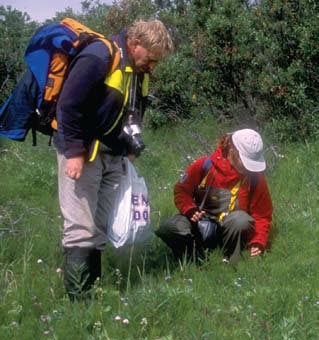
C. Parker
Range extensions of East Beringian rare plants into northwestern Alaska and the Arctic Network parklands
Carex deflexa Hornem. (Cyperaceae) was collected in a dry meadow near Reed Hot Springs in Gates of the Arctic NPP during the 2002 I&M Arctic Network inven-tory (Parker 2006a). The species is known from boreal North America and Greenland, and is found in the Yukon-Tanana uplands of interior Alaska. This record of C. deflexa is a northwestward range extension of over 250 miles (400 km). The species is ranked globally secure and critically imperiled to imperiled in Alaska (G4S1S2).
Schizachne purpurascens (Torr.) Swallen (Poaceae) was also found growing in a dry meadow adjacent to Reed Hot Springs in Gates of the Arctic NPP during the 2002 I&M Arctic Network inventory (Parker 2006a). This grass of boreal Asia and North America is known from south of the Alaska Range, hence this record documents a northward range extension of approximately 375 miles (600 km). Schizachne purpurascens is ranked secure globally and imperiled in Alaska (G5S2).
Eriophorum viridicarinatum (Engelm.) Fernald (Cyperaceae) was collected in a species-rich bog meadow southwest of Walker Lake in Gates of the Arctic NPP during the 2002 I&M Arctic Network inventory (Parker 2006a). A cottongrass of boreal North America, this record is a northward range extension of over 315 miles (500 km). Eriophorum viridicarinatum is ranked secure globally and imperiled in Alaska (G5S2).
Oxytropis tananensis Jurtzev (Fabaceae) is a yellow-flowered oxytrope that was first described from a xeric steppe bluff above the Tanana River in interior Alaska (Yurtsev 1993). A review of herbarium specimens has extended the known range of the species to additional Tanana River sites and the Porcupine River valley. The 2001 I&M Arctic Network inventory documented the species from the Anisak River valley in Noatak NP, a north-westward range extension of 375 miles (600 km) (Parker 2006a). Oxytropis tananensis is ranked imperiled to rare (G2G3S2S3).
Lupinus kuschei Eastw. (Fabaceae) was first known from sandy habitats in northern British Columbia and southern Yukon, Canada (Dunn and Gillett 1966). An NPS inventory in Wrangell-St. Elias NPP documented the species from the Sanford River, and additional collections document the species from Nogahabara Dunes (Koyukuk National Wildlife Refuge), the Kugarak River headwaters (Selawik National Wildlife Refuge), Great Kobuk Sand Dunes (Kobuk Valley NP), and from the vicinity of Whitehorse, Yukon. The disjunct distribution within East Beringia of L. kuschei, as well as those of Symphyotrichum yukonense, noted below, could be linked to the ancient East Beringian landscape on which the open sandy and gravelly habitats they prefer were more widespread. Lupinus kuschei is ranked rare globally and imperiled in Alaska (G3S2).
Symphyotrichum yukonense (Cronquist) G.L. Nesom (Asteraceae) was first described (as Aster yukonensis) from the Kluane Lake area of southwestern Yukon, Canada, where it grows on saline flats of the Slims River (Cronquist 1945). The species was later documented from the Great Kobuk Sand Dunes in Kobuk Valley NP, from the central Bettles River valley, and from the Oolah Valley in Gates of the Arctic NPP. During the 2003 I&M Arctic Network inventory, S. yukonense was found along the middle Noatak River floodplain in Noatak NP at several localities. The species is ranked rare (G2S3).
References
Al-Shehbaz, I.A., J.R. Grant, R. Lipkin, D.F. Murray, and C.L. Parker. 2007.
Parrya nauruaq (Brassicaceae), a new species from Alaska. Novon 17(3): 275-278.
Cayouette, J., and S.J. Darbyshire. 1993.
The intergeneric hybrid grass ‘Poa labradorica’. Nordic Journal of Botany 13: 615-629.
Cronquist, C. 1945.
A new Aster from Yukon. Madroño 8: 97-99.
Dunn, D.B., and J.M. Gillett. 1966.
The Lupines of Canada and Alaska. Canada Department of Agriculture, Research Branch, Monograph No. 2.
Keil, D.J. 2006.
Saussurea. In Flora of North America Volume 19, Asteraceae, part 1, edited by Flora of North America Editorial Committee. Oxford University Press, New York.
Kelso, S. 1987.
Primula anvilensis (Primulaceae): a new species from northwestern Alaska. Systematic Botany 12(1): 9-13.
Kelso, S., B.A. Yurtsev, and D.F. Murray. 1994.
Douglasia beringensis (Primulaceae): a new species from northwestern Alaska. Novon 4(4): 381-385.
Parker, C.L. 1999.
Floristic inventory of selected sites in the Nulato Hills, western Alaska. Unpublished report submitted to Bureau of Land Management, Anchorage Field Office.
Parker, C.L. 2000.
Floristic inventory of selected sites in the Lime Hills USGS Quadrangle, southwestern Alaska. Unpublished report submitted to Bureau of Land Management, Anchorage Field Office.
Parker, C.L. 2001.
Vascular plant inventory of selected sites in the Waring Mountains and vicinity, Selawik National Wildlife Refuge, northwestern Alaska. Unpublished report submitted to U.S. Fish and Wildlife Service.
Parker, C.L. 2006a.
Vascular plant inventory of Alaska’s Arctic National Parklands. Final Report. ARCN I&M, National Park Service, Alaska Region. Report no. NPS/AKRARCN/ NRTR-2006/01.
Parker, C.L. 2006b.
Botanical inventory of the ‘Moon Mountains’, southwestern Seward Peninsula, Alaska. Unpublished report submitted to Bureau of Land Management, Kotzebue Field Office.
Yurtsev, B.A. 1993.
Oxytropis tananensis- a new species of section Baicalia (Fabaceae) from the interior of Alaska. Botanicheskii Zhurnal 78 (9): 59-64. (Translation from Russian by Irina Lapina).
Part of a series of articles titled Alaska Park Science: Volume 8, Issue 2: Park Science in the Arctic.
Last updated: August 10, 2016
